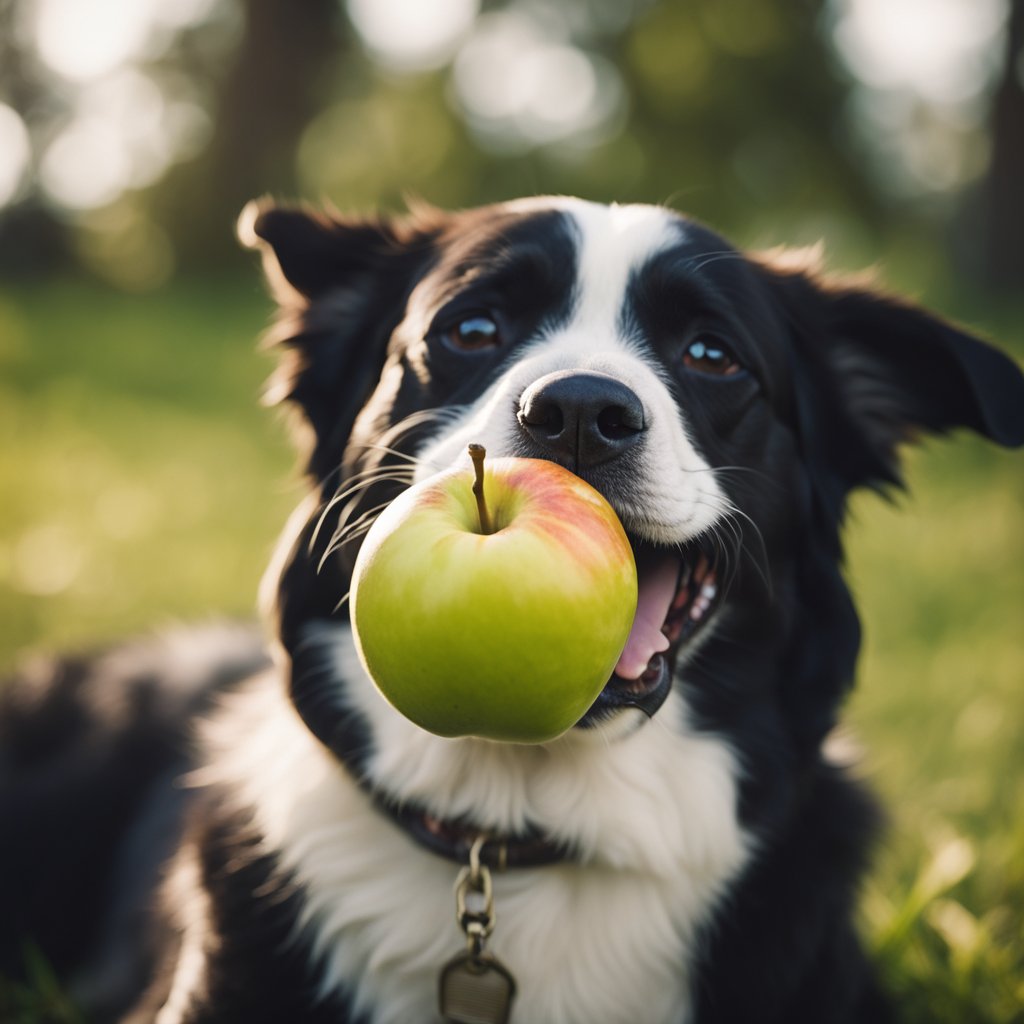Can Dogs Eat Apples? Understanding the Benefits and Risks
Apples can be a tasty and healthy snack for your dog when prepared properly. Yes, dogs can eat apples, but it’s important to feed them without the seeds or core. These crunchy fruits offer several vitamins and benefits that can enhance your dog’s diet. Choosing safe treats like apples can help you take better care of your furry friend.

Before you share apples with your dog, it’s essential to consider the right way to prepare them. Understanding how much and which parts are safe will keep your pet happy and healthy. You’ll also want to learn about potential risks that can come with feeding apples to dogs.
With the right knowledge, you can enjoy sharing this nutritious fruit with your pet. You’ll find that a little bit of information goes a long way in making informed choices about your dog’s treats.
Key Takeaways
- Apples can be a nutritious treat for your dog when given correctly.
- Always remove the seeds and core before feeding apples to your dog.
- Moderation is key to ensuring your dog’s diet remains balanced.
Health Benefits and Risks

Apples can be a healthy snack for your dog, providing various nutrients. However, there are important health risks to keep in mind. Understanding both the nutritional value and the precautions will help you make informed choices.
Nutritional Value of Apples for Dogs
Apples are packed with nutrients that can benefit your dog’s health. They contain:
- Vitamins: Apples are a good source of Vitamin A, Vitamin C, and Vitamin K. These vitamins support your dog’s immune system and overall health.
- Fiber: The fiber in apples aids digestion. This can help keep your dog’s digestive system regular.
- Low-Calorie Snack: Apples are low in calories, making them a great option for treats without adding extra weight.
Make sure to wash the apples thoroughly before feeding them to your dog. Cutting them into slices or small cubes can make them easier to eat. Always remove the seeds and core, as they can be harmful.
Risks and Precautions When Feeding Apples
While apples offer benefits, there are risks you need to consider. Here are some precautions:
- Seeds and Core: Apple seeds contain cyanide, which is toxic to dogs. Always remove seeds and the core before feeding.
- Digestive Issues: Some dogs may have trouble digesting the fiber in apple peels. This can lead to an upset stomach.
- Moderation is Key: Apples should be given as an occasional treat, not a daily staple. Too many apples can lead to digestive problems and weight gain.
Monitor your dog after feeding them apples. If you notice any signs of distress, consult your vet for advice.
Best Practices for Feeding Apples to Dogs

Feeding your dog apples can be a healthy treat when done correctly. You should focus on how to prepare apples properly and understand the right portions to maintain your pet’s health.
How to Prepare Apples for Dogs
Before giving apples to your dog, it’s important to prepare them safely. Start by washing the apple thoroughly to remove any pesticides or chemicals on the skin.
Next, slice the apple into small pieces to make them easy for your dog to eat. This helps prevent choking hazards, especially for small breeds.
It’s essential to remove the seeds and core, as these contain harmful compounds that can be toxic. While the flesh of the apple is safe and healthy, the seeds can lead to digestive issues if consumed in large amounts.
Peeling the apple is optional. Some dogs may find it easier to digest without the skin. Always monitor your dog when trying a new food to watch for any allergic reactions or digestive issues.
Recommended Portions and Frequency
When feeding apples to your dog, moderation is key. It’s best to start with small portions, such as one to three slices per day, depending on your dog’s size.
For small dogs, one slice is usually enough. Larger dogs can safely enjoy more, but keep an eye on their overall calorie intake.
Too much apple can upset your dog’s stomach or lead to diarrhea. Always consider your dog’s diet, including other treats and food.
Aim to offer apples as an occasional snack rather than a regular part of their diet. This helps maintain a balanced nutrition plan while still allowing your dog to enjoy the fruit’s health benefits.
Resources

If you’re looking for trustworthy information on whether dogs can eat apples, here are some helpful links:
- American Kennel Club: Learn about which fruits and vegetables dogs can safely eat, including apples. Visit their article here.
- WebMD: Find out more about the benefits and safety of apples for dogs. Their detailed guide can be accessed here.
- Dogster: This site offers vet-reviewed nutrition facts about apples and other foods safe for dogs. Check out their information here.
- Forbes: Discover safety precautions for feeding your dog apples as a treat. Read more on their website here.
- PetMD: For a comprehensive look at pet care and nutrition including fruits, check their resources here.
These resources will help you ensure that you are making safe and healthy choices for your dog’s diet. Always consult with your vet if you have specific concerns regarding your dog’s diet.
Frequently Asked Questions

When it comes to feeding apples to your dog, you may have several questions about safety and benefits. Below are specific inquiries and answers regarding apple consumption for dogs.
Are apple cores safe for dogs to consume?
Apple cores are not safe for dogs. The seeds inside the core contain a small amount of cyanide, which can be harmful if ingested in significant quantities. It’s best to remove the core and seeds before giving your dog any apple pieces.
Is it safe for dogs to eat apple peel?
Yes, dogs can eat apple peel. The skin provides fiber and some nutrients. However, if your dog has a sensitive stomach, it might be a good idea to peel the apple before serving it.
How much apple is too much for a dog?
Moderation is key when feeding apples to dogs. A few small slices or cubes are usually safe for most dogs. Too much apple can lead to stomach upset or diarrhea.
Which fruits are toxic to dogs?
Some fruits are toxic to dogs. Grapes and raisins can cause kidney failure, while cherries can be harmful due to their pits. Always research any fruit before giving it to your pet.
Can dogs eat cooked apples without any risks?
Yes, dogs can eat cooked apples. They must be free from added sugars, spices, or sweeteners that could harm your dog. Cooked apples can be easier to digest and still provide health benefits.
Are there health benefits for dogs eating apples?
Apples can offer several health benefits for dogs. They are a good source of vitamins A and C and provide fiber, which aids digestion. Just make sure to serve them in moderation and remove any harmful parts.

